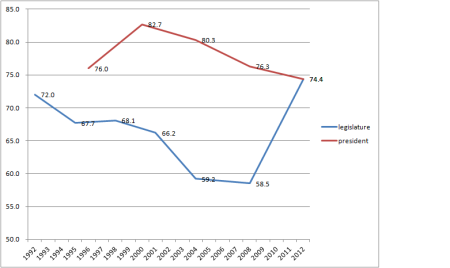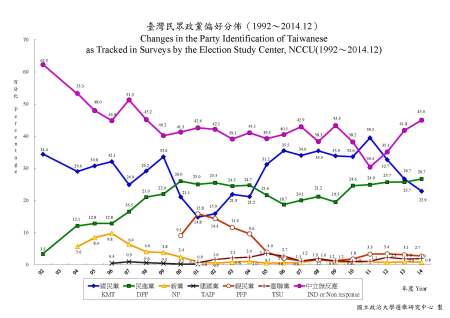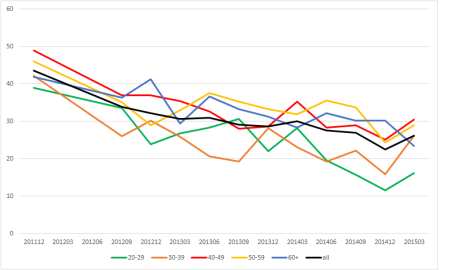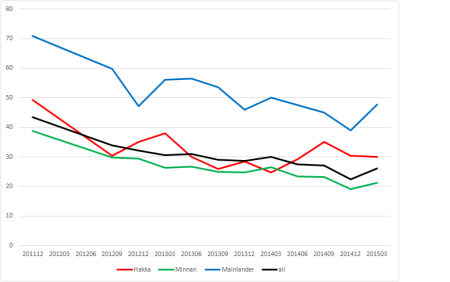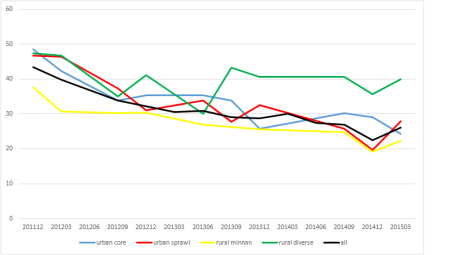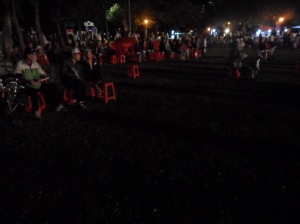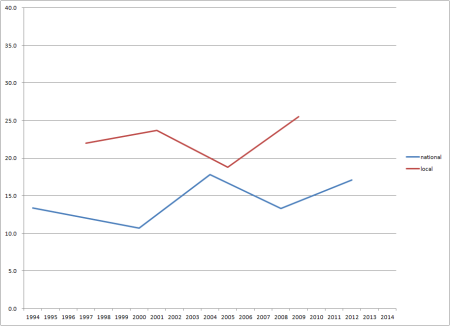After Sunday afternoon’s presidential debate, Mrs. Garlic and I headed off to a KMT evening rally in Taoyuan. The rally was to open the northern Taoyuan campaign office. Taoyuan is traditionally split into the Min-nan north and the Hakka south, so this district was responsible for the three predominantly Min-nan districts (Taoyuan 1, Taoyuan 4, and Taoyuan 6). Taoyuan 6 is probably not competitive, and the DPP didn’t bother to nominate its own candidate. However, Taoyuan 1 and 4 are two districts that I am watching with keen interest. Of the three predominantly Hakka districts, Taoyuan 2 looks likely to go to the DPP, while Taoyuan 3 and 5 are probably not in play. The common thread in the three solid blue districts is a large military and mainlander population.
Every time I look at the 2012 and 2014 election results from Taoyuan, my brain hurts. The numbers just don’t make sense. Two decades of election observation tells me that patterns of competition in Taiwan are quite stable. Then 2014 blindsided me. The rest of the world paid attention to Taipei and Taichung, but Taoyuan was the race that shocked me and convinced me that something very fundamental had shifted.
Let’s look at some numbers. In 2012, the KMT won all six legislative races and Ma won the presidential election by a sizeable margin.
| Ma | Tsai | KMT LY | DPP LY | |
| 1 | 54.4 | 42.7 | 55.3 | 44.7 |
| 2 | 52.5 | 44.6 | 50.2 | 49.8 |
| 3 | 60.7 | 36.4 | 53.9 | 39.9 |
| 4 | 56.0 | 41.1 | 58.2 | 40.6 |
| 5 | 60.9 | 36.1 | 45.3 | 35.1 |
| 6 | 59.1 | 37.8 | 60.3 | 31.3* |
| all | 57.2 | 39.9 | 53.9 | 40.4 |
*In D6, the DPP supported an independent in 2012. This year, they are supporting a different independent in D6.
In 2012, the DPP had two incumbents, since they had won by-elections in Taoyuan 2 and 3. Note that these two candidates ran strong races, but both were unable to overcome the partisan disadvantage. The KMT candidates in D3 and D5 lost significant numbers of votes to 3rd party candidates.
Those are big margins, and there is very little hint that the DPP might be competitive anywhere except perhaps its traditional coastal stronghold (D2) any time soon. Now here are the 2014 elections, in which the DPP somehow reversed all these numbers. I have also broken down these results by legislative district. The third and fourth columns are the city council results, which I’ll get to later.
| Wu (KMT) | Cheng (DPP) | KMT CC | DPP CC | |
| 1 | 43.4 | 55.6 | 43.2 | 38.4 |
| 2 | 47.5 | 51.3 | 30.4 | 41.8 |
| 3 | 52.1 | 46.9 | 35.4 | 24.3 |
| 4 | 42.6 | 56.4 | 44.2 | 31.6 |
| 5 | 52.0 | 47.0 | 35.4 | 22.8 |
| 6 | 50.0 | 49.0 | 35.1 | 33.3 |
| All | 48.0 | 51.0 | 37.1 | 32.2 |
Comparing Wu to Ma, the KMT lost an average of 9.2%, with much lower losses in the (more rural) coastal D2 and higher losses in northern D1 and D4. Perhaps it isn’t surprising that Wu’s losses were higher in northern Min-nan D1, D4, and D6, since Wu 吳志揚 is Hakka and Cheng 鄭文燦 is Min-nan. This year, most legislative races will pit Hakka against Hakka or Min-nan against Min-nan, so there won’t be a big ethnic advantage in any locale. In other words, all else equal, the DPP might not do quite as well as Cheng in D1, D4, and D6, but it might do a bit better in D2, D3, and D5. Still, it appears to me that D1 and D4 are at the epicenter of whatever was driving last year’s earthquake. In particular, the area that changed most dramatically is the region from Guishan to Taoyuan, roughly the stretch along Freeway #1 closest to the Taipei metro area.
There are many people who would like to dismiss the 2014 result as a function of a strong DPP candidate and a weak KMT candidate. However, this is not consistent with survey data. TEDS did a pre-election survey (about 3 weeks before the election). One of the questions asked people rate how much they liked each candidate on a scale of 0 to 10. 36.4% rated Wu higher, while only 28.6% rated Cheng higher. Another question asked what the most important issue was and then asked who would be better at handling that issue. Most people didn’t give an answer, but of the ones who did, 18.3% thought Wu would be better while only 13.9% though Cheng would be better. Remember, this is AFTER the corruption scandal involving Wu’s deputy mayor. Voters didn’t elect Cheng based on his personal popularity.
If it wasn’t the candidate, it almost necessarily had to be the party. TEDS did a post-election survey after the 2009 county magistrate election, and found that the KMT had a 39.9-24.7% edge in party ID. I don’t know what the numbers were in Taoyuan in 2012, but the national numbers were fairly stable during Ma’s first term. I imagine they weren’t far from 40-25%. In the 2014 pre-election poll, the party ID numbers were completely different, with the DPP leading 26.8-26.2%. In other words, the KMT went from a 15.2% advantage in party ID to a 0.6% deficit. This is what propelled Cheng into the mayor’s seat.
How do those numbers translate into legislative districts? I suppose I could break them out, but I won’t for two very good reasons. First, I can’t do it precisely. Since Taoyuan and Zhongli districts are split among different legislative districts, I’d have to know which neighborhood each respondent lived it. TEDS did not ask that question. Second, even if I could do it, I probably shouldn’t. With a total sample size of 1000, each of six districts would have a sample size of less than 200. If your subsample doesn’t have at least 400 respondents, it is probably too small to tell you anything useful. (Remember this the next time you look at survey results. The media is always breathlessly reporting results based on tiny subsamples.)
Instead of giving precise numbers, let’s do this qualitatively. If the two parties are tied in PID overall, we can certainly guess that the KMT has an advantage some areas while the DPP has an advantage in others. In particular, the KMT probably still has an edge in D3, D5, and D6. This must mean that the DPP has an edge in D1, D2, and D4. I don’t know how big those edges are, but I’m pretty sure that the three KMT incumbents in D3, D5, and D6 are effectively running downhill, while the three KMT incumbents in D1, D2, and D4 are running uphill.
To put it another way, given Tsai Ing-wen’s enormous lead in the polls right now, she will probably beat Chu in all six of Taoyuan’s legislative districts. She will probably also win an outright majority (beating Chu plus Soong) in D1, D2, and D4. The question then is whether those KMT incumbents can create enough split tickets to make up the deficit.
I’m most skeptical about Liao Cheng-ching 廖正井, the KMT incumbent in D2. Liao won the district eight years ago, but he had the seat stripped due to vote-buying and the DPP won the seat in a by-election. Liao’s conviction was overturned on appeal (on what I consider dubious grounds) just before the KMT finalized its 2012 nominations. Since he was no longer ineligible, the KMT reshuffled its plans and nominated him. He squeaked out a razor-thin victory, running behind President Ma and well behind the larger blue camp vote. He has had four years to work the district, but I’m not convinced he has ever been that strong. This year his opponent is also a Hakka from Yangmei, so he can’t call for local or ethnic solidarity. (According to her Wikipedia page, the DPP’s husband has a spotty criminal record (read: he is/was in organized crime). So this race is between a gangster’s wife and a convicted vote buyer. Hooray for democracy!) I think Liao is probably going down.
The other two are harder to predict. Chen Ken-te 陳根德 (D1) has been in the legislature since 1998, and Yang Li-huan 楊麗環 (D4) has been in since 2001. Both came up from the grassroots. Chen was previously in the county council, where he served a term as speaker, while Yang started her career as a neighborhood chief. These two have been working grassroots connections forever. Of all the competitive districts this year, these might the two with the strongest personal bases. They’re certainly in the top five. Will that be enough to overcome the partisan deficit?
Go back to those city council results. There is quite a gap between the mayoral results and the council results. The mayoral election is essentially a national-level fight. Voters think of it in national partisan terms. It’s not too much to suggest that a vote for Wu was a vote of confidence in President Ma while a vote for Cheng was a vote against Ma and for Tsai. The city council vote was much more local. Some voters voted on national partisan considerations, but many voters made their choices based on local networks, patronage, friendship, family recommendations, local development projects, constituency service, and so on. Independent candidates don’t have much space for survival in national politics (unless they are actually running as the unofficial representative of one of the big parties), but independents got significant numbers of votes in every city council district. In some, independents got as much as 40% of the vote. Even in D4 (Taoyuan), which had the weakest set of independents, independents still got over 10%. Moreover, since independent candidates usually take most of their votes from the blue pool, many people who vote for the DPP in national-level elections are voting for the KMT in local-level elections.
Technically, a mayor is a local official while a legislator is a national-level official. However, a mayor is much higher up the chain of power. As I have said many times, municipal mayoral winners are automatically on the short list for the presidency. In contrast, many legislators treat their office like a glorified township mayor, spending much more time worrying about the state of local roads or constituency service than on national legislation. In other words, when it comes to voting, a legislator is significantly more local than a municipal mayor. The KMT legislators in D1 and D4 are particularly locally-oriented, and they would love for voters to see these races as local contests. The critical question, then, is whether voters will make their choices thinking about President Ma or the project to upgrade their local playground.
The rally was in a tiny space right next to the campaign office. I’ve never understood why organizers feel the need to hold rallies right next to the office just because the rally has been designated as an office-opening event. We were jammed into an intersection of two narrow streets. The crowd couldn’t spill out off the streets because we were in the middle of muddy fields. I don’t think it was possible to jam more than 2500 people into the cross, and most of them had terrible viewing angles. The crowd had almost all been bused in, and it was dead.
Let me pause here for a digression. A couple weeks ago, I went to the rally to open Chu’s southern Taoyuan campaign office. It was huge, with maybe 12,000 people completely filling a huge space. I had to squeeze along the edges for about 15 minutes just to find some open space. It wasn’t just big. It was rocking! It might have been the most enthusiastic rally I’ve been to this year. Chu wasn’t doing well at all nationally and the Jennifer Wang 王如玄 controversy was breaking wide open, but his people in Taoyuan turned out in force to support him. It was an emotional display unlike anything I’ve seen in New Taipei or anywhere else. Chu was their boy, and they were behind him 100%. I thought I would be going to a similar rally last night, but it wasn’t anything like the one two weeks ago. Last night’s rally was tiny and cold. Two weeks ago, the atmosphere was raucous, defiant, and maybe even optimistic. Last night, it was defensive and maybe a little defeatist. I’m not suggesting the campaign is running out of steam or anything like that. I’m just surprised that the people in one office in one part of Chu’s hometown could organize such a great event while the people in the other part did such a terrible job.
It wasn’t entirely the audience’s fault that they were bored. This event had one of the most uncharismatic lineups of speakers that I have ever sat through. Chu’s former deputy magistrate was almost a caricature of a droning bureaucrat, and he was supposed to be the person whipping up a fever for Chu’s big entrance. Who decided to let him near the microphone? More surprisingly, the three legislative candidates were also pretty bad at public speaking. I guess they must be REALLY good at constituency service.
Chen Ken-te remarked that the KMT still hadn’t emerged out of the shadow of last year’s election debacle. He then explained the reason for that defeat: the KMT had let down its guard and hadn’t fully mobilized. In other words, Chen was insisting that there is no need for the KMT to engage in any painful soul-searching or reform. They just need to make sure they mobilize all their voters. A couple other speakers echoed this theme. One of them talked about the 40% of voters who are hesitant to tell survey interviewers that they support the KMT. Presumably, he was assuming that the 40% undecided are all going to vote for Chu, so the KMT is actually well on its way to winning this election. These people who are willfully ignoring all the signs of the impending disaster! They are like children putting their hands over their ears and screaming “La, la, la, I don’t hear you!”
The city council vice speaker touched on another prominent theme: the KMT has a sparkling record in local politics. He claimed that under Chu and Wu, Taoyuan had a better record of local development than any other city or county in Taiwan. Several of them pointed to the area we were in, which was a newly redistricted area and had several building projects. They also talked proudly about the plan to develop the land around the airport. When Eric Chu spoke, he pointed to a new road he had overseen that was now lined with tall buildings. This was not your ordinary laundry list; they were genuinely bragging about what they considered to be a great job. As one of them wondered, How can the voters possibly vote against us after we have done all this?
I think this might be precisely where they are failing. Every time I go to Taoyuan, my impression is that Taoyuan is, well, difficult. The cities are particularly cramped, the roads are too narrow, the water quality and supply is terrible, industrial pollution is a problem, and there just isn’t enough public infrastructure. Things might get better after the MRT lines open and they might be better in the newly developed areas, but I think the old neighborhoods where most people live are still going to be difficult. As for their vaunted land development, I wasn’t that impressed. These were former agricultural fields that they could have done anything with. I saw lots of narrow streets that will be inadequate to support the large populations in the tall buildings they are planning. It’s as if no one makes any profit by building wider roads. We are still reaping the benefits of the Japanese bureaucrats who built wide roads in downtown Taipei and Kaohsiung. Future generations will wonder why KMT planners couldn’t do the same in Taoyuan. When KMT politicians crow about their great construction achievements, I wonder if they don’t alienate more people than they impress.
I have one more note about the D4 race that doesn’t seem to fit in anywhere, so I’ll tack it on at the end. The DPP candidate in D4 is an old warhorse, Cheng Pao-ching 鄭寶清. He has been around since the mid-1990s, but he never made much of an impression on me. During the second Chen term, he lost the 2005 magistrate election, and he was then given a sinecure as the head of the Taiyen (Taiwan Salt) corporation. Mrs. Garlic tells me that he was the one who spearheaded Taiyen’s highly profitable move into the cosmetics market. Wikipedia says he has founded three biotech companies since leaving Taiyen. But that’s not the fun part. A week or so ago, I went to a rally for Chen Lai Su-mei 陳賴素美, the DPP candidate in D2. Apparently, she once worked as Cheng’s aide, so Cheng showed up to stump for her. I only remember one thing he said. He is the thirteenth child in his family. There are sixteen altogether. All sixteen have the same mother and the same father, and mom gave birth to sixteen kids in sixteen years. When Tsai Ing-wen showed up, I couldn’t help but remember that she is the eleventh child. Can you imagine someone having sixteen or eleven children today? In all the ways that Taiwan has changed over the past centuries, this might be one of the most dramatic.
